|
|
April 21, 2023
This e-newsletter delivers announcements from EPA's Office of Resource Conservation and Recovery on rulemakings, guidance documents, reports, research, upcoming webinars, and more.
|
|
Happy Earth Day!
Earth Day, April 22, is a day to learn about and remember the importance of protecting our planet all year long. Check out this infographic to learn more about simple ways to make every day Earth Day.
|
|
EPA Seeks Comment on the Draft National Strategy to Prevent Plastic Pollution
Today, EPA released a “Draft National Strategy to Prevent Plastic Pollution,” which is part of EPA’s Series on Building a Circular Economy for All, for public comment. The strategy provides voluntary actions that can be implemented in the United States aimed at eliminating the release of plastic waste from land-based sources into the environment by 2040. This strategy builds upon EPA’s National Recycling Strategy and focuses on actions to reduce, reuse, collect, and capture plastic waste.
New and innovative approaches are necessary to reduce and recover plastic materials and improve economic, social, and environmental impacts. With input from organizations, EPA identified three key objectives for the strategy:
Objective A: Reduce pollution during plastic production.
Objective B: Improve post-use materials management.
Objective C: Prevent trash and micro/nanoplastics from entering waterways and remove escaped trash from the environment.
EPA is interested in receiving feedback on the actions proposed in this strategy, including which of the proposed actions are the most important and would have the greatest positive impact at the local, regional, and national level. Check out the draft strategy on our website, as well as information on how to submit comments.
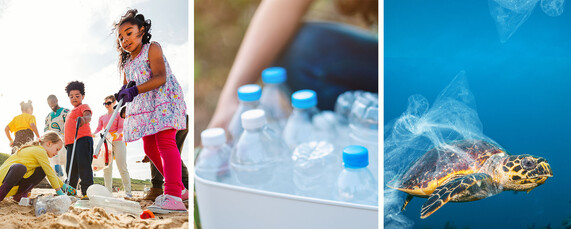
Join us for a webinar about this draft strategy on May 11 from 1:00 pm – 2:00 pm (Eastern Time). Register now!
|
|
EPA Publishes the Recycling Infrastructure and Market Opportunities Map
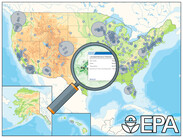
Today, EPA also published the Recycling Infrastructure and Market Opportunities Map to support the National Recycling Goal and the building of new recycling infrastructure through the Bipartisan Infrastructure Law.
By providing a comprehensive resource for understanding opportunities about post-consumer materials management, this first version of the Recycling Infrastructure and Market Opportunities Map can help:
- Develop and strengthen primary and secondary end markets for materials.
- Support cleaner communities by reducing the amount of plastic and other waste entering landfills.
- Provide opportunities to address climate change by diverting more materials from landfill.
This tool visually presents data estimates from all phases of the recycling process, including generation, collection, sortation, and end use. EPA will solicit public comments on the Recycling Infrastructure and Market Opportunities Map Version 1.0 and will encourage users to provide their feedback and recommendations.
|
|
|
EPA Announces Updated Wasted Food Estimates
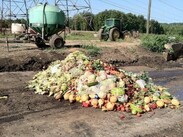
On April 4, 2023, EPA published the 2019 Wasted Food Report. This report provides estimates for 2019 on the generation and management of wasted food in the U.S. for the food retail, food service, residential, and food manufacturing and processing sectors. It also includes estimates of how those sectors manage their wasted food.
EPA estimates that in 2019, 66.2 million tons of wasted food was generated in the food retail, food service, and residential sectors. Of this, 40% was from households, 40% was from food service providers, and 20% was from food retail. Most of this waste (59.8%) was landfilled. An additional 40.1 million tons of wasted food was generated by the food manufacturing and processing sectors. The biggest proportion of this food manufacturing and processing waste (42.6%) was managed by anaerobic digestion.
The report also contains information on progress toward the national goal to reduce food loss and waste by 50% by 2030. For food waste, this goal aims to cut in half the amount of food from the food retail, food service, and residential sectors that has been removed from the human food supply chain compared to a 2016 baseline of 328 pounds per person. In the three years between the baseline (2016) and the latest national data (2019), there was a slight increase of six percent (from 328 pounds to 349 pounds per person).
For more information and to access this report, please visit our food data webpage.
|
|
|
EPA Releases its Fourth Summary Report on Anaerobic Digestion Facilities Processing Food Waste in the United States
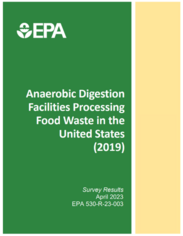
On April 4, 2023, EPA released the Anaerobic Digestion Facilities Processing Food Waste in the United States (2019) report, the fourth report under the Anaerobic Digestion Data Collection Project. This report provides 2019 data collected through surveys of stand-alone digesters, on-farm co-digestion systems, and water resource recovery facilities with co-digestion systems. Operators who responded to the survey processed a combined amount of over 17.5 million tons of food waste in 2019 and produced biogas in the amount equivalent to generating enough energy to power almost 58,333 homes for a year.
EPA’s Anaerobic Digestion Data Collection Project aims to increase understanding of how food waste is handled at anaerobic digestion facilities nationwide. As interest grows in the anaerobic digestion and biogas industries and in decreasing and diverting food waste from landfills, the data in these reports will be useful to policy makers, investors, and other interested parties. You can also find previous reports featuring data from 2015, 2016, 2017 and 2018 on our website.
|
|
|
EPA Published a Beneficial Use Evaluation of Flue Gas Desulfurization (FGD) Gypsum in Agriculture
On March 21, 2023, EPA and the U.S. Department of Agriculture published a beneficial use evaluation of FGD gypsum in agriculture, an unencapsulated use of coal combustion residuals. A goal of this evaluation is to demonstrate how EPA’s Beneficial Use Methodology and Compendium, which provides an analytical framework to evaluate the potential for adverse environmental impacts from a wide range of industrial materials and their proposed beneficial uses.
The evaluation identified no concerns for most modeled application scenarios. Based on these results, we conclude that application of FGD gypsum to farm fields at the agriculturally appropriate rates considered in this evaluation can provide benefits while remaining protective of human health and the environment.
EPA encourages the beneficial reuse of industrial non-hazardous secondary materials, including coal combustion residuals, provided it is done in a responsible and protective manner. For more information and to access this evaluation, Methodology, and Compendium, visit our webpage on coal ash reuse.
|
|
EPA's Office of Resource Conservation and Recovery (ORCR) Summarizes Fiscal Year 2022 Accomplishments
On April 20, 2023, ORCR issued its fiscal year 2022 Accomplishments Report. The report helps us share with the public the many ways we help protect the environment and public health. From developing completely new programs to improving recycling to implementing new grant programs to advancing waste management on tribal lands to many more accomplishments and initiatives, it was a busy year for ORCR. Read all about it in the Fiscal Year 2022 Accomplishments Report. |
|
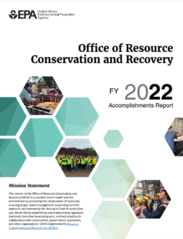 |
|
|
|
The purpose of this newsletter is to provide interested parties with updates about the federal solid and hazardous waste programs, such as information about rulemakings, upcoming webinars, guidance documents, open comment periods, and other related communications.
|
|
|
|
|